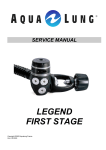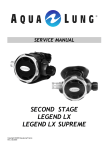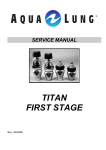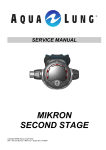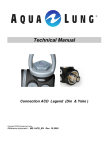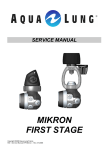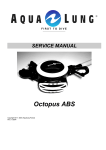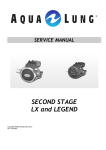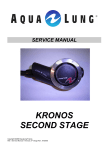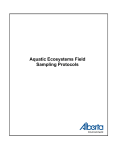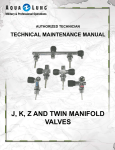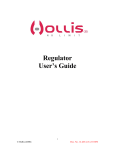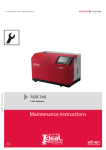Download Aqua Lung Kronos Service manual
Transcript
SERVICE MANUAL KRONOS FIRST STAGE Copyright ©2006 Aqualung France Ref : Service Manual-HP Kronos Rev. 07/2006 2 Kronos First Stage Service Manual Index COPYRIGHT............................................................................................................................... 3 INTRODUCTION........................................................................................................................ 3 WARNINGS, ATTENTION, NOTES..........................……………............................................... 3 MAINTENANCE.......................................................................................................................... 3 GENERAL INSTRUCTIONS........................................……........................................................ 3 GENERAL CONVENTIONS....................................................................………………….......... 3 DISASSEMBLY PROCEDURE................................................................…................................4 RE-ASSEMBLY PROCEDURE................................................................…................................7 ADJUSTING THE FIRST STAGE................................................................….............................9 FINAL ASSEMBLY…...................................................................................................................11 Table 1. Troubleshooting guide............................................……................................................12 Table 2. List of tools and service kits..................................................…………...........................13 Table 3. Recommended cleaners and lubricants................................….................................... 14 Procedure A. Cleaning and lubricating.........................................................................................15 Table 4. Torque settings......................................................................………............................. 16 Table 5. Checking specifications..........................................................……................................17 Exploded view of Kronos First Stage....…............................................……................................18 F I R S T T O 3 D I V E COPYRIGHT GENERAL INSTRUCTIONS This manual is the property of Aqualung France. Any copying, photocopying, reproduction, translation, electronic distribution (email, Internet...), even partial, and in whatever format, is expressly forbidden without the written consent of Aqualung France. 1. In order to carry out the procedures described in this manual correctly it is important that you follow the steps in the exact order indicated. Read the manual through completely so that you become familiar with all the procedures, the special tools and the replacement parts, before starting to disassemble the product. Keep this manual open near to you so that you can refer to it step by step. Do not rely on your memory. 2. All servicing and repair procedures should be carried out in a workshop that is clean, well lit, easy to access and specially fitted for the purpose. 3. The regulator body should never be directly held in the jaws of a vice. To hold the body, screw the tool 006230 into the HP port and then grip the tool with the vice. 4. Once the regulator has been disassembled, the reusable components should be separated from the components that need to be replaced. Fragile items with seats or crowns with critical sealing surfaces should be separated and protected during servicing in order to prevent any damage. WARNINGS, ATTENTION, NOTES 5. Certain icons have been used to facilitate the reading and understanding of this manual. They have the following meanings : Use only spare parts from Aqualung service kits. Never replace an Aqualung part with one from another manufacturer, even if it appears similar. 6. Never re-use regulator parts which should be replaced on the pretext that the regulator has seen little use since its manufacture or since its last service. 7. When reassembling, check that the torque used conforms with that shown in Table 4, Torque. Some parts can be irretrievably damaged if the acceptable torque is exceeded. ©2006 Aqua Lung France. INTRODUCTION This manual gives the instructions and the recommendations for the disassembly, the cleaning, the checking, the reassembly and the adjustment of an Aqualung regulator. This manual is not an instruction manual for unqualified personnel. The procedures described in this manual are intended only for qualified personnel who have been trained in the servicing of Aqualung equipment during a specialised course. If you do not understand certain procedures in this manual you should contact an Aqualung service consultant before undertaking any operation. . WARNING: Indicates situations that could result in serious or fatal accidents if the advice given is not followed correctly. . ATTENTION: Indicates a situation or action that could cause serious damage to the product, making it dangerous if the advice given is not followed correctly. GENERAL CONVENTIONS NOTE : Notes are used to emphasize important points as well as information which needs to be remembered. 1. Unscrew: to unscrew a threaded part, turn it anticlockwise. 2. Screw: to screw a threaded part, turn it clockwise. 3. Remove the O-ring: To remove an O-ring follow the method below, using the special tool provided for this purpose. Any tool that could damage the O-ring should be avoided. In every case, replace the O-ring removed with a new one. MAINTENANCE Attention: Whatever the number of dives carried out during a year, the regulator should receive a complete service each year. If the regulator is used in a chlorinated or aggressive environment the service period should be reduced to six months. In order to conform with the Aqualung Regulator Lifetime Guarantee, all servicing (inspection, servicing and repairs) should be recorded in the Service Record incorporated in the regulator User Manual. The conventions described below define the actions to be carried out when an instruction is given. Press simultaneously on the two sides of the O-ring in order to form an ‘eye’. . Insert the special tool into this eye to remove the O-ring. 4 Kronos First Stage Service Manual 4. The acronyms used: LP: Low Pressure MP: Medium Pressure HP: High Pressure 5. Numbers in brackets indicate the part number of the component shown on the exploded view attached. 1. Unscrew the hoses from the first stage using the appropriate spanner. Screw the holding tool (116320) into a free HP port and grip the tool in a vice. 2. Disassembly of the ACD connection on the yoke version. DISASSEMBLY PROCEDURE Note: Before commencing disassembly, consult the exploded view to check the reference numbers of all parts requiring replacement. These parts should all be replaced by new parts and should not be re-used on the pretext that the regulator has seen little use since its manufacture or since its last service. Unscrew the yoke seat (127576). Remove the assembly seat + yoke + yoke screw + dust cap. Remove the filter (A05106) and the seal (820016). Remove the elastomer washer (127575) Attention: Use only the special tool when removing O-rings in order to avoid damaging the seal recess. The slightest scratch on a sealing surface could cause a leak. If a surface should be damaged then this part should be replaced with a new one. Do not use any pointed instrument or metal tool to remove O-rings. 2.1 Tighten the yoke screw, compressing the dust cap, grip the assembly in a vice, tighten the hex nut of the yoke seat. Using a 3mm allen key, turn it in a clockwise direction to unscrew the nut (129207) F I R S T T O 2.2 Completely unscrew the yoke nut, then the dust cap to remove the mechanism completely. Extract the two Orings. 3. 5 D I V E Disassembly of the ACD connector on the DIN version, 4. Using a 7/16’ rod’, remove the shutter screw. (127573), then remove the seal (124703) 5. Remove the DIN hand wheel Remove the cap (129216). Take a DIN/yoke adapter (Ref : 125237 ) and screw it completely home on the DIN handwheel in order to compress the spring. 6. Using a 26mm flat spanner, unscrew the DIN seat (127572) then remove the seal (820016) 7. Remove the filter (A05106). 8. Using a 1/2’’ spanner remove the spring block (127562). Remove the spring block and the spring (122244) 3.1 Unscrew the nose (129202) using an allen key. 3.2 Unscrew the DIN/yoke adapter. Remove the seat (129203) and the spring (129204). Remove the 2 Orings on the seat (124709) and (473057) 6 9. Kronos First Stage Service Manual Remove the O-ring (124612) and the AE ring (119129) 14. Disassembly of the dry chamber (Kronos Supreme). Turn the body over and using a lug spanner (129198) unscrew the diaphragm nut (127582). Remove the diaphragm (127579), and then the piston (127581). 10. Turn the body over to recover the valve (124624) and the needle (127564) 11. Disassembly of the wet chamber. Turn the body over and remove the elastomer washer (127586). Using a 8mm allen key unscrew the adjusting screw (127566). 15. Using a 8 mm allen key, unscrew the adjusting nut (127566). Remove the washer (127568) and then the spring (127567). Remove the elastomer washer (127587). Using a 32mm spanner, unscrew the nut (127577). 12. Remove the washer (127568) and the MP spring (127567). Using a 32mm spanner, unscrew the wet chamber (127588) 16. Manually remove the diaphragm (119159), the spring base (127565) and then remove the spring (127563) 13. Remove the spring base (127565), the diaphragm (119159) and the spring (127563) F I R S T T O 7 D I V E 17. Remove the body from the vice, turn it over, and recover the seat (127585) using the seat tool (116236). Remove the seat seal (124704) RE-ASSEMBLY PROCEDURE Fit a new lubricated O-ring (124704) on the seat (127585). Slide the seat onto the tool (116236), push the seat into the body (HP side) to position the seat and push with the tool. 1. Screw the holding tool (116320) into a port and grip the body in a vice. Fit the valve (124624) (with its face toward the inside of the body) and fir the spring (122244). 18. Remove the MP (122233) and HP (122237) plugs. Remove their O-rings (124703) et (124701). Note: Before continuing, closely examine the antiextrusion washer (119129). You will note that it has a flat side and a concave side. For correct assembly the concave side should be against the O-ring, as shown in the picture below. END OF DISASSEMBLY O-ring Before starting to re-assemble the regulator, make sure that all replacement parts have been cleaned and lubricated in accordance with Procedure A : Cleaning and Lubricating on page 14. Anti extrusion washer 2. Fit a new lubricated anti-extrusion washer (119129) then a new lubricated O-ring (124612) in the spring block (127562). Using a small brush add a little grease to the inside of the spring block. 8 Kronos First Stage Service Manual 4. 5. Fit the spring block (127562) on the spring. Screw the spring block fully home inside the body. Reassembly of the yoke version Fit a new lubricated O-ring (124703) inside the seat. 9. Grip the assembly in a vice and then using a torque wrench, screw the nose at 0.2m.kg in an anticlockwise direction. 10. Remove the assembly from the vice, unscrew the yoke nut. Check that the shutter is about 1.5mm proud. Check that the shutter acts correctly by compressing it with your thumb. 6. Fit the nose (129207) into the seat and fit a clean lubricated O-ring (473056) around the nose. 11. Turn the assembly over with the threaded part uppermost. Fit the filter (A05106) and then the seal (820016). Fit the washer on the body (127575). 7. Fit the spring (129204) inside the yoke seat (127576) then fit the shutter seat onto the spring. 8. Fit the assembly into the yoke. Introduce the cap between the yoke and the shutter, screw the yoke screw (127574) so that the spring is compressed. Stop screwing when the shutter is in this position. The yoke screw will become hard to screw. Manually screw the body fully home onto the seat, ensuring that the seat is held in a vertical position. Take care that the filter and O-ring are not dislodged from their position. 12. Reassembly of the DIN version. Fit the O-ring (820016) onto the DIN seat (127572). Fit the filter (A05106) inside the seat. F I R S T T O D I V E 9 16. Fit the spring (129204) inside the handwheel then the seat (129203) on the spring. 13. Holding the seat vertical, with the seal and filter uppermost, manually screw the body down onto it taking care that the filter and O-ring are not dislodged from their position. Screw the holding tool (116320) into an outlet, turn the body over and grip the tool in a vice. Using a torque wrench, tighten the seat (127572) to 2.5 m.kg. 17. Screw the DIN/yoke adaptor right down to compress the spring. Engage the nose (129202) in the screw and screw the nose in at 0.2 m.kg using a torque wrench. Remove the adaptor and then remove the regulator from the vice. 14. Fit the DIN handwheel (127571). Fit a new lubricated Oring (124703) on the shutter screw (127573). Fit the screw into the handwheel and continue screwing using a 7/16’’ torque wrench at 1.5 m.kg. 18. Turn the body over then put the assembly back in the vice. Fit the needle (127564) then the button (127563). 19. Reassembly of the wet chamber version. Fit the diaphragm (119159) into its position in the wet chamber (127583). Tighten the wet chamber at 2.5 m.kg using the rod (122152). 15. Fit the O-ring (473057) and O-ring (124709) into the seat (129203) 10 15. Fit the spring base (127565), the spring (127567), and the washer (127568). Kronos First Stage Service Manual 19. Screw the MP adjusting screw (127566) until you see the first threads of the dry chamber. ADJUSTING THE FIRST STAGE a. Screw an MP gauge (0-25 bar) into one of the MP ports. If the gauge is not fitted with an over-pressure valve, then it is vital that the second stage is fitted so that it can act as an over-pressure valve in the event of an HP leak. b. Connect the first stage to a cylinder charged to 200bar. Slowly open the cylinder valve to put the regulator under pressure. c. After checking that there is no leak, adjust the MP by turning the adjusting screw: Screwing in increases the MP, unscrewing reduces the MP. 16. Fit the MP screw (127566) then fit the washer (127586). 17. Reassembly of the dry chamber (Kronos Supreme) Fit the diaphragm (119159) into its position in the dry chamber (127577). Tighten the chamber at 2.5 m.kg using the tool (122152) Attention: if the MP indicated rapidly exceeds 9.5bar then this indicates a HP leak. Close the cylinder valve immediately and purge the regulator. Refer to Table 1. Troubleshooting Guide. Turn the screw by increments of 1/8 of a turn and purge the regulator several times, using the second stage, after each increment. Adjust the MP (see Table 5). 18. Fit the washer (127587), the spring base (127565), the spring (127567) and the washer (127568). Once the MP has been adjusted, purge the second stage about ten times. When this is finished check the pressure gauge. The MP should be stable at the desired value (8.5b or 9.5b depending on the regulator). Make any further adjustments that may be necessary. Leave the regulator under pressure for several minutes and check that the MP remains stable. If the MP rises more than 0.3 bar this indicates that there is a leak. Refer to Table 1. Troubleshooting Guide. 20. Close the cylinder valve and completely purge the regulator. Put the regulator under pressure once more and check that the MP is stable. If the MP is different, repeat steps 3 and 4 until a stable pressure is obtained. F I R S T T O FINAL ASSEMBLY (cf VE 103191) Note: The following step should be carried out with the regulator under pressure. 1. 11 D I V E With the regulator under pressure, insert the piston (127581) into the dry chamber. Place the diaphragm (127579) right to the bottom of the diaphragm screw (127582). Screw it fully home on the body using a lug spanner (129198) TEST IN WATER Check that all the MP and HP plugs are in place and that a correctly adjusted second stage is connected to the first stage. Slowly open the cylinder valve to put the regulator under pressure. Immerse the first stage completely in water to check that there are no leaks. Note: Do not mistake any bubbles that are trapped in the regulator with a leak. If there is a leak there will be a constant stream of bubbles. When you are sure that there is no leak, close the cylinder valve and purge the regulator. Remove the first stage from the cylinder and refit the dust cap. If a leak has been detected then note its source and refer to Table 1. Troubleshooting Guide. 2. Check that the MP is still stable (see table 5) 3. Close the cylinder valve and purge the regulator. Remove the pressure gauge and replace the MP plug. END OF REASSEMBLY 12 Kronos First Stage Service Manual Table 1. Troubleshooting Guide SYMPTOM Increase in MP (likely to cause a second stage leak) External leak Reduced airflow or significant breathing resistance on complete regulator. POSSIBLE CAUSE TREATMENT 1. The HP seat (124624) is worn or damaged. 1. Replace the HP seat. 2. The crown (127585) is damaged. 2. Replace the crown 3. The O-ring (124704) is worn or damaged. 3. Replace the O-ring 4. Groove on the spring block (127562) damaged 4. Remplacer le barillet 5. O-ring (124612) is worn or damaged. 5. Replace the O-ring 6. O-ring groove on the crown on the body is damaged 6. Replace the body 1. O-rings on the MP a and HP plugs are worn, extruded or damaged. 1. Replace the O-ring(s) 2. The diaphragm(119159) is worn or damaged. 2. Replace the diaphragm 3.The diaphragm (127579) is worn or damaged. 3. Replace the diaphragm 4. The sealing face of the diaphragm is damaged. 4. Replace the body 5. Dry chamber screw (127577) or (127583) loose. 5. Tighten the dry chamber 6. Seat O-ring (820016) damaged 6. Replace the O-ring 7. Nose O-ring (473056) damaged 7. Replace the O-ring 8. Shutter screw seal (124703) damaged 8. Replace the O-ring 9. ACD seat seal(473057) damaged 9. Replace the O-ring 1. Cylinder valve not completely open 1. Open the valve, check the cylinder pressure 2. Cylinder valve requires servicing 2. Try another cylinder 3. Filter (26) blocked 3. Replace the filter 4. The cylinder is empty 4. Charge the cylinder F I R S T T O 13 D I V E Table 2. List of Tools and Service Kits REF 116222 DESCRIPTION APPLICATION MP pressure gauge complete 0/16B Checking medium pressure US PART NO. 111610 Lug spanner Loosening/tightening diaphragm nut 129198 N/C O-ring tool Fitting and removing O-rings 944022 Seat assembly/disassembly 109436 For holding 1st stage in vice 100395 Socket wrench tightening seat 111001 Seat fitting tool 116236 116230 Holding tool Socket wrench A11001 Dry chamber socket 122152 Wet and dry chamber tightening socket n/a 122154 Torque wrench 2.5 m.kg Seat, dry chamber n/a 122152 Torque screwdriver Plugs n/a N/C Extension Socket extender n/a N/C Spanner Dry chamber n/a N/C Allen key 4mm MP and HP plugs n/a N/C Allen key 8mm MP adjustment, unscrew plug (20) n/a N/C Hexagonal tool 7/16” Spring block n/a N/C Hexagonal tool ½ “ Shutter screw N/a DIN/yoke adaptor Disassembly of nose DIN ACD n/a Allen key 3mm Tighten nose yoke ACD n/a Service Kit HP Kronos All versions 125237 N/C 127681 14 Kronos First Stage Service Manual Table 3. Recommended cleaners and lubricants LUBRICANT / CLEANER Christolube MCG 111 APPLICATION All O-rings SOURCE Aqualung, ref. 480025 Attention: Silicone parts do not require lubrication. Do not grease them. Greasing silicone parts can change their molecular construction and cause premature degradation of the material. Oakite #31 Acid bath for cleaning brass and stainless steel parts. Oakite Products, Inc. NETALU Acid bath for cleaning brass and stainless steel parts. Aqualung, ref. 455001 Diluted white vinegar Acid bath for cleaning brass and stainless steel parts. Household stores Attention: Do not use hydrochloric acid for cleaning parts. Hydrochloric acid, even when well diluted, attacks the coating of metal parts and leaves a corrosive deposit that damages plastic parts and O-rings. Washing-up liquid (diluted with hot water) Degreases brass and stainless steel parts; Household stores general cleaning of plastic and rubber parts. Disinfectant STERANIOS 2% Disinfectant for all plastic and metal parts. Aqualung ref : 382062 F I R S T T O 15 D I V E Procedure A Cleaning and Lubricating (All Aqualung Regulators) Cleaning brass and stainless steel parts. 1. 2. 3. Pre-clean by soaking in NETALU diluted to 25%. Cleaning in an ultra-sonic bath filled with a mixture of washing-up liquid + hot water. If some resistant deposits remain then fill the ultrasonic bath with white vinegar and repeat. DO NOT put plastic, rubber, silicone or anodised aluminium parts in contact with vinegar. Rinse in demineralised or fresh water to avoid calcium deposits. Soak for 10 minutes. Dry with filtered low pressure air and then check that their condition is now suitable for re-use. Cleaning plastic, rubber and anodised aluminium parts. For anodised aluminium parts : soak in a « NETALU diluted to 25% ». Rinse in fresh water and dry with low-pressure filtered air. For plastic parts. (casings, plugs..) : clean in an ultrasonic bath containing a mixture of washing-up liquid and hot water. Use only a toothbrush with nylon bristles to remove any deposits. Rinse in fresh water and dry with low-pressure filtered air Attention: D not place plastic and rubber parts in contact with acid solutions. This could alter their physical properties and cause degradation and premature breakdown. Disinfecting parts . For disinfection, leave plastic and metal parts to soak for 20 minutes in a bath of STERANIOS 2% ref. 382062 (ready to use). Rinse the parts thoroughly after soaking. Toxic product, follow the instruction for its use. Cleaning parts for Nitrox/O2 use. 1. 2. 3. 4. Metal parts : Pre-clean by soaking in NETALU diluted to 25%. Ultrasonic cleaning in Promoclean TP108 diluted at 5% . Rinse in demineralised water. Soak for 10 min. Dry in the open air in a clean and dust-free atmosphere. Place the parts on a white cloth, allow to dry and check after drying that the cloth shows no grease deposits and that the condition of the parts is appropriate for re-use with Nitrox/O2. Cleaning hoses. If there is significant corrosion then it is permissible to soak only the ends in an ultrasonic bath, avoiding any possibility of the solution entering the hose. Rinse in fresh water and allow to dry with the connections hanging down. Dry the inside with filtered compressed air before reconnecting the hose to the regulator. Wiping. To wipe parts, use a white filter paper, a pure cotton cloth or any other material that does not produce fluff. Inspection. Visually check under a white light (day light or artificial light). The parts are completely free of any traces of : 1. 2. 3. 4. organic materials (oil, grease, paint, rust…) cleaning agents dust humidity Lubrication. When handling O-rings wear unpowdered latex gloves. It is important not to allow contact between the internal components and the skin or any other source of contamination when the regulator is being prepared for Nitrox use. All seals should be lubricated with Christolube MCG111. Cover the seals with a light film of grease and remove any excess by rolling the seal between finger and thumb. Do not use an excess of grease; this can have the effect of accumulating particles that could damage the O-rings. 16 Kronos First Stage Service Manual Table 4. Torque values REFERENCE N° DESCRIPTION FORCE 127583 Wet chamber nut 2.5 m.kg. 127577 Dry chamber nut 2.5 m.kg 127576 Yoke seat 2.5 m.kg. 127572 DIN seat 2.5 m.kg. 127573 DIN shutter screw 2.5 m.kg 129207 Yoke nose shutter 0.2 m.Kg 129202 DIN nose shutter 0.2 m.Kg 127582 Diaphragm nut En butée 127562 Spring block En butée Table 5. Checking specifications TEST INSTRUCTIONS SPECIFICATIONS Leak Test 160 bar < Working pressure < 200 bar No leak Medium Pressure 160 bar < Working pressure < 200 bar KRONOS standard and Supreme : MP at 9.5 bar ± 0.5 bar MP Variation 160 bar < Working pressure < 200 bar After purging the regulator several times, the MP should not increase by more than 0.3 bar in 5-15 seconds. F I R S T T O 17 D I V E Maintenance Notes. 18 Kronos First Stage Service Manual Exploded View of First Stage Kronos Yoke. F I R S T T O 19 D I V E Exploded View of First Stage Kronos DIN. 20 Kronos First Stage Service Manual Exploded View of First Stage Kronos Supreme Yoke. F I R S T T O D I V E Exploded View of First Stage Kronos Supreme DIN. 21 22 Kronos First Stage Service Manual 1ere Avenue – 14e rue – BP 148 06513 CARROS cedex – France 00.33.(0)4.92.08.28.88 FAX 00.33.(0)4.92.08.28.99























